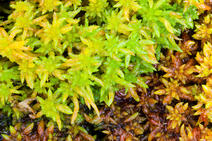The plant that formed the blanket bogs of the Peak District is being reintroduced on a scale never seen before in the UK.
Used in the First World War as a wound dressing due to its antiseptic properties, Sphagnum moss will help heal the scars on the landscape caused by erosion and pollution from the Industrial Revolution that has left bare peat exposed.
The team at the Moors for the Future Partnership is at the forefront of the development of innovative ways to reintroduce Sphagnum in this often hostile environment.
Over the next four years Sphagnum moss will be reintroduced to over 1700 hectares of the Peak District National Park and South Pennines with around 1.7 million plug plants and clumps of this peat-forming moss set to be planted.
The £1.25 million investment is funded from various sources including Natural England and the EU LIFE programme through the partnership’s MoorLIFE 2020 project.
Matt Buckler, Programme Manager for Conservation and Land Management at the Moors for the Future Partnership, said: “Reintroducing Sphagnum moss is a critical part of our work to conserve and protect active blanket bog and rewet the moors.
“Sphagnum mosses are amazing plants that are able to hold between ten and 20 times their weight in water. These tiny plants play a major role in keeping water on the hills for longer, reducing the risk of wildfires and of flooding downstream.
“Their action in slowing down the flow of water reduces the erosion of peat which is a vital contribution to climate change targets, as there is a huge amount of carbon stored in the peat soils of the UK. The plants act as a filter; cleaning the water before it gets into reservoirs and saving on costs of water treatment.”
Dave O’Hara, Senior Site Manager from RSPB’s Dove Stone reserve, said: “We’re delighted to be working as part of the Moors for the Future Partnership to complete these vital works.
“Partnership work is fundamental in helping to make a difference to our threatened peatland landscapes.
“There is good evidence that blanket bog restoration can help to conserve upland breeding bird populations, and we want to do all we can to fulfil the RSPB’s overarching goal to save threatened birds and wildlife across the UK.”
Sphagnum shapes the bulk of the blanket peat in the uplands of the UK, forming well known landscapes such as Kinder Scout and Black Hill, with peat being slowly laid down over thousands of years.
Once plentiful, vast areas of the moss were killed off by industrial pollution but improvements in air quality mean that it can grow again. This will allow carbon to be taken out of the atmosphere and stored indefinitely in new peat, a process called sequestration, which will help in the battle against climate change.
Ground-breaking research has already led to the development of new ways to introduce Sphagnum moss in the form of beads, slime and plug plants with on-going monitoring to assess its effectiveness.
A new cutter to help harvest Sphagnum from donor sites where the moss is still plentiful is currently being developed.
The public can also play their part by working with Moors for the Future to help monitor changes in the amount of Sphagnum there is, and the types of places it is growing.
By carrying out this crucial citizen science role, collecting data which will feed into the Big Moss Map, they are helping scientists and conservationists in their efforts to conserve the blanket bog habitat.
Could you help? To find out more or to get involved go to
http://www.moorsforthefuture.org.uk/community-science/bigmossmap
